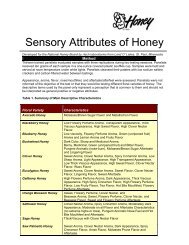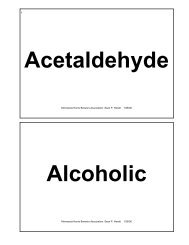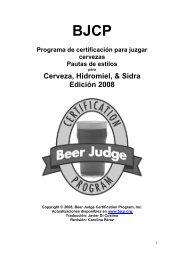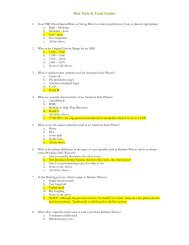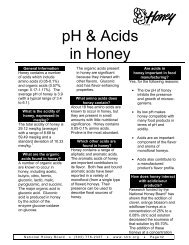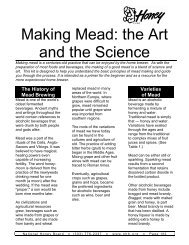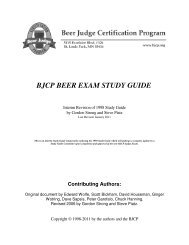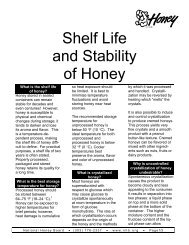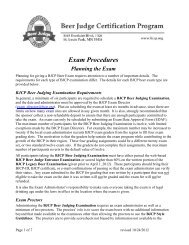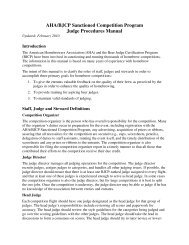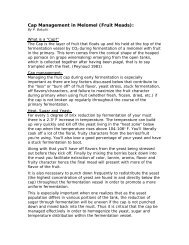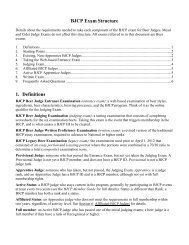Style Flashcards - BJCP
Style Flashcards - BJCP
Style Flashcards - BJCP
Create successful ePaper yourself
Turn your PDF publications into a flip-book with our unique Google optimized e-Paper software.
5B. Traditional Bock<br />
Category: 5. Bock<br />
OG: 1064 – 1072 FG: 1.013 - 1.019 ABV: 6.3 – 7.2%<br />
IBU: 20 – 27 SRM: 14 – 22<br />
Commercial Examples: Einbecker Ur-Bock Dunkel, Aass Bock, Great Lakes Rockefeller Bock<br />
History: Originated in the Northern German city of Einbeck.<br />
Aroma: Strong malt aroma, often with moderate amounts of rich melanoidins and/or toasty overtones. Virtually no<br />
hop aroma. Some alcohol may be noticeable. Clean. No diacetyl. Low to no fruity esters.<br />
Appearance: Light copper to brown color, often with attractive garnet highlights. Lagering should provide good<br />
clarity despite the dark color. Large, creamy, persistent, off-white head.<br />
Flavor: Complex maltiness is dominated by the rich flavors of Munich and Vienna malts, which contribute<br />
melanoidins and toasty flavors. Some caramel notes may be present from decoction mashing and a long boil. Hop<br />
bitterness is generally only high enough to support the malt flavors, allowing a bit of sweetness to linger into the finish.<br />
Well-attenuated, not cloying. Clean, with no esters or diacetyl. No hop flavor. No roasted or burnt character.<br />
Mouthfeel: Medium to medium-full bodied. Moderate to moderately low carbonation. Some alcohol warmth may be<br />
found, but should never be hot. Smooth, without harshness or astringency.<br />
Overall Impression: A dark, strong, malty lager beer.<br />
Ingredients:<br />
• Water: Water hardness can vary, although moderately carbonate water is typical of Munich.<br />
• Malt: Munich and Vienna malts, rarely a tiny bit of dark roasted malts for color adjustment.<br />
• Hops: Continental European hop varieties are used.<br />
• Yeast: clean lager yeast<br />
• Other: Decoction mashing and long boiling plays an important part of flavor development. Never any nonmalt<br />
adjuncts.<br />
Copyright © 2004, <strong>BJCP</strong>, Inc. All rights reserved.<br />
5C. Doppelbock OG: 1072 – 1096+ FG: 1016 – 1024+ ABV: 7 – 10+%<br />
Category: 5. Bock IBU: 16 – 26+ SRM: 6 - 25<br />
Commercial Examples: Paulaner Salvator, Ayinger Celebrator, Spaten Optimator, Tucher Bajuvator, Augustiner<br />
Maximator, Weihenstephaner Korbinian, Weltenburger Kloster Asam-Bock, EKU 28, Eggenberg Urbock 23º<br />
Aroma: Very strong maltiness. Darker versions will have significant melanoidins and often some toasty aromas. A light caramel<br />
flavor from a long boil is acceptable. Lighter versions will have a strong malt presence with some melanoidins and toasty notes.<br />
Virtually no hop aroma, although a light noble hop aroma is acceptable in pale versions. No diacetyl. A moderately low fruity aspect<br />
to the aroma often described as prune, plum or grape may be present (but is optional) in dark versions due to reactions between malt,<br />
the boil, and aging. A very slight chocolate-like aroma may be present in darker versions, but no roasted or burned aromatics should<br />
ever be present. Moderate alcohol aroma may be present.<br />
Appearance: Deep gold to dark brown in color. Darker versions often have ruby highlights. Lagering should provide<br />
good clarity. Large, creamy, persistent head (color varies with base style: white for pale versions, off-white for dark<br />
varieties). Stronger versions might have impaired head retention, and can display noticeable legs.<br />
Flavor: Very rich and malty. Darker versions will have significant melanoidins and often some toasty flavors. Lighter<br />
versions will a strong malt flavor with some melanoidins and toasty notes. A very slight chocolate flavor is optional in<br />
darker versions, but should never be perceived as roasty or burnt. Clean lager flavor with no diacetyl. Some fruitiness<br />
(prune, plum or grape) is optional in darker versions. Invariably there will be an impression of alcoholic strength, but<br />
this should be smooth and warming rather than harsh or burning. Presence of higher alcohols (fusels) should be very<br />
low to none. Little to no hop flavor (more is acceptable in pale versions). Hop bitterness varies from moderate to<br />
moderately low but always allows malt to dominate the flavor. Most versions are fairly sweet, but should have an<br />
impression of attenuation. The sweetness comes from low hopping, not from incomplete fermentation. Paler versions<br />
generally have a drier finish.<br />
Mouthfeel: Medium-full to full body. Moderate to moderately-low carbonation. Very smooth without harshness or astringency.<br />
Overall Impression: A very strong and rich lager. A bigger version of either a traditional bock or a helles bock.<br />
Ingredients:<br />
• Water: Water hardnes s varies from soft to moderately carbonate.<br />
• Malt: Pale versions -Pils and/or Vienna malt; Darker ones - Munich and Vienna malts<br />
• Hops: Noble hops<br />
• Yeast: Clean lager yeast<br />
Copyright © 2004, <strong>BJCP</strong>, Inc. All rights reserved.



